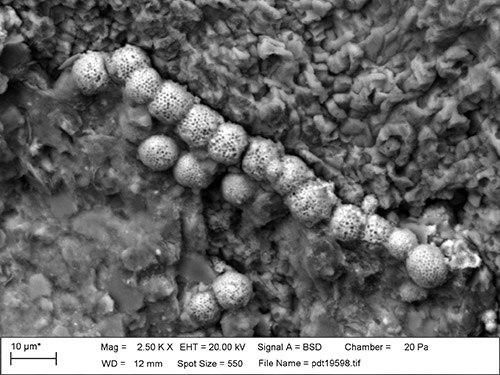
Mark Wilson and British Colleague Publish Remarkable Discovery of 450 Million-Year-Old Bacterial Mats

WOOSTER, Ohio – Mark Wilson, the Lewis M. and Marian Senter Nixon Professor of Natural Sciences and Geology at The College of Wooster, and a British colleague published the cover story of the November 2017 issue of Palaios, an international journal dedicated to the study of the impact of life on Earth’s history, on their discovery of three-dimensionally preserved bacterial mats on 450-million-year-old shells.
The article, “Exceptional Pyritized Cyanobacterial Mats Encrusting Brachiopod Shells from the Upper Ordovician (Katian) of the Cincinnati Region,” summarizes their serendipitous finding, which took place at the Natural History Museum in London.
“These are bacterial mats that encrusted the shells and were essentially unknown to us prior to finding these fossils. Knowing now what kinds of bacteria these were changes our models of the ecology of these encrusting communities,” Wilson explained. “These shells often have numerous other organisms that attached to them. These bacterial mats provided a biofilm that would have affected their recruitment and persistence. We expected that these mats existed way back then, but this is our first direct evidence and they’re preserved in extraordinary 3-D, microscopic detail.”
Wilson and Paul Taylor, a merit researcher in the department of earth sciences at the museum, were examining a fossil collection from the 19th century with a scanning electron microscope when the long-time colleagues happened upon the exciting discovery.
They recognized the cyanobacteria, very tiny photosynthetic organisms that look like beads on a string, right away. These cyanobacteria, found on the concave exterior surfaces of dorsal brachiopod valves, are among the oldest and longest-lived taxa in the fossil record, an “extraordinary group,” according to Wilson.
The 450-million-year-old age was determined through radioactive dating of the rocks in which the fossils that were found, and “it fits within what we know about the ecology of these organisms,” said Wilson. “There was a shallow ocean in the Cincinnati area at this time, which in itself is kind of a cool concept.”
Wilson also noted the importance of museums and the preservation of their collections. “This work is adding a new dimension to the fossil record, so we encourage other scientists to look at other shells for similar records. Somebody collected the shells we studied in the 1800s and put them in a drawer. Now in the 21st century, we can use modern tools and make discoveries on old specimens,” he said. “This demonstrates the value of museums and the curators who manage their collections for generations to come.”
Image: Here is a sample of the 450-million-year-old bacterial mats, encrusted on a shell, that Wooster professor Mark Wilson helped discover.
Posted in News on December 21, 2017.
Related Posts
Related Areas of Study
Geology
Start research in your first year and graduate with a strong foundation in the Earth Sciences.
Major Minor

